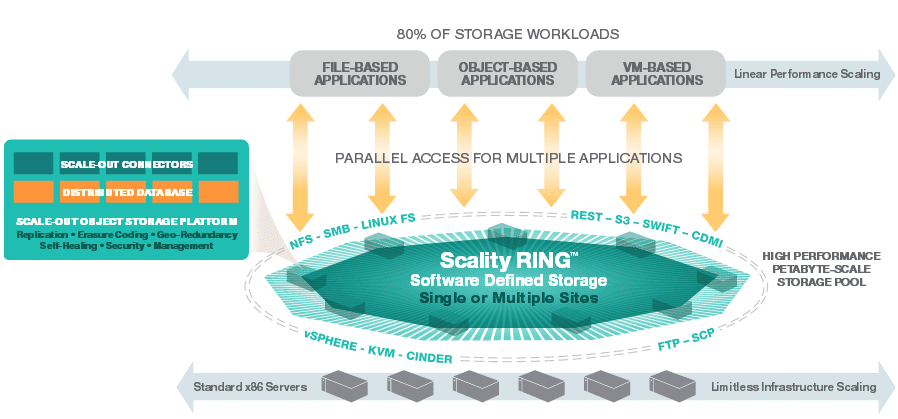
Scality today announced the general availability of version 5.0 of its RING software-defined storage platform. RING uses a parallel architecture that can be deployed across commodity x86 servers in order to provide storage services that scale linearly to hundreds of petabytes and billions of objects. RING is hardware-agnostic and supports SSD and HDD storage media.
A RING storage infrastructure can be scaled out across multiple active sites with thousands of servers. RING deployments can be designed to tolerate site failure along with multiple rack, server, or disk failures. RING features customer-configurable data protection policy at the object level with up to 6 object-level copies and ARC (Erasure Coding) to reduce overhead for large objects.
New details have emerged about RING 5.0 since the update was first announced in August 2014. RING 5.0 now incorporates connectivity options for Microsoft Windows Clients and Windows Servers in the form of a native SMB connector. RING 5.0 has also added support for Debian Linux 7.6 (Wheezy) in addition to existing support for RedHat, CentOS, and Ubuntu Linux distributions. RING also provides storage services to applications through storage protocols such as NFS, S3, OpenStack Swift, and Cinder.
According to Scality, the company’s channel partners and resellers comprise 80 percent of RING’s customer base. Those stakeholders will benefit from a new RING 5.0 user interface for automated installation to commodity servers via an open source agent-based tool. Clients should expect a simplified point-and-click installation experience that will allow administrators with a wider range of skillsets to configure RING in a shorter time than RING 4.3.
Customers planning to deploy RING storage for use in video streaming, archiving, content distribution, and enterprise cloud tools should also see performance improvements with RING 5.0. These gains stem a more CPU-efficient erasure-coding library for the RING’s Advanced Resiliency Configuration (ARC) feature along with faster bulk file system operations and improvements to the CDMI REST Connector that allow it to support more simultaneous clients.
Pricing and Availability
RING 5.0 is available for download today from the Scality customer portal. Licensing is based on usable capacity, meaning that only the primary copy of an object counts against the licensed capacity. The Scality RING Core bundle includes basic HTTP/REST and OpenStack Swift connectivity with add-ons for RS2, FUSE, NFS/SMB, CDMI, and KVM VM support. A High Performance Flash RING bundle is also available.


